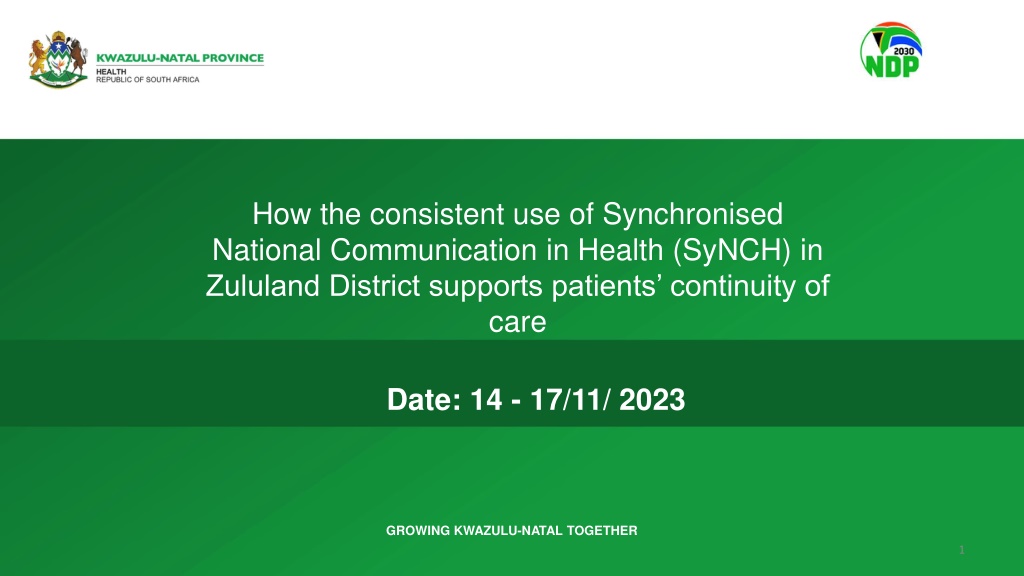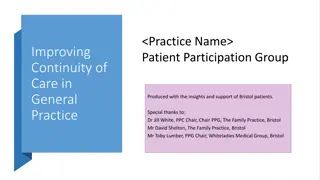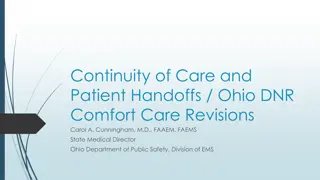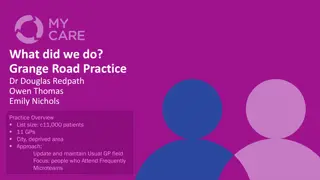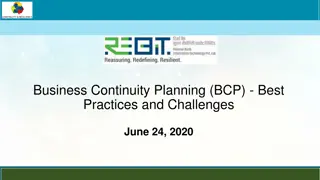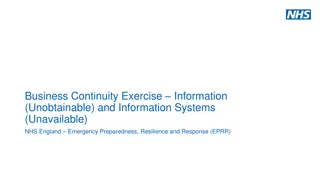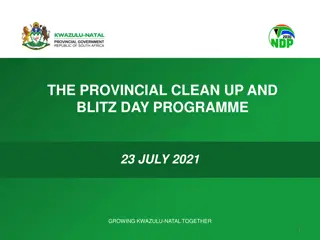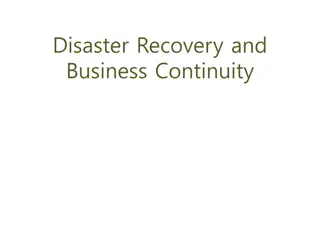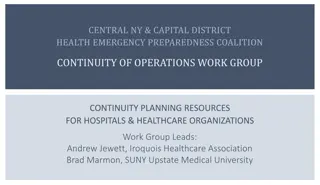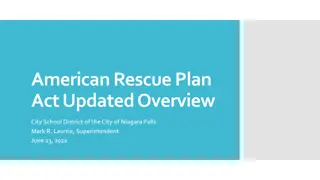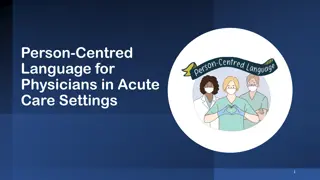Enhancing Patient Care Continuity in Zululand District through SyNCH Implementation
Zululand District in KwaZulu-Natal has implemented the Synchronised National Communication in Health (SyNCH) system to support patients' continuity of care. This real-time web system enhances process flows, ensures compliance with treatment guidelines, and monitors medication collection, benefiting chronic patients through the Central Chronic Medicines Dispensing and Distribution program. The district's healthcare facilities have shown progress in implementing SyNCH, with ongoing support from the Health Systems Trust and the National Department of Health.
Download Presentation

Please find below an Image/Link to download the presentation.
The content on the website is provided AS IS for your information and personal use only. It may not be sold, licensed, or shared on other websites without obtaining consent from the author. Download presentation by click this link. If you encounter any issues during the download, it is possible that the publisher has removed the file from their server.
E N D
Presentation Transcript
GROWING KWAZULU-NATAL TOGETHER How the consistent use of Synchronised National Communication in Health (SyNCH) in Zululand District supports patients continuity of care Date: 14 - 17/11/ 2023 GROWING KWAZULU-NATAL TOGETHER 1
GROWING KWAZULU-NATAL TOGETHER Presentation Layout BACKGROUND AND INTRODUCTION CHALLENGES PRIOR TO SYNCH IMPLEMENTATION STREAMLINING SCRIPTING IMPLEMENTATION OF SYNCH LIMITATIONS IN IMPLEMENTATION AND REMEDIAL ACTION STRATEGIES IMPLEMENTED AND SUSTAIN SYNCH USAGE REGISTERED PATIENTS VS REJECTIONS ACHIEVEMENTS 2
GROWING KWAZULU-NATAL TOGETHER BACKGROUND AND INTRODUCTION Zululand District is situated in the Northern part of the Province of KwaZulu-Natal. It is neighboured by King Cetshwayo District in the south; UMkhanyakude District in the North-East , Mpumalanga Province and Swaziland in the North, Amajuba District in the Northwest and UMzinyathi District in the Southwest. It is the largest district in km in the province, making up 16% of its geographical area. It is estimated to be 14 799km with a population density of about 57.7 persons per km It comprises five local municipalities: Ulundi, Nongoma, uPhongolo, eDumbe and Abaqulusi. It is primarily a rural district. Source: The Local Government Handbook South Africa 2017. A complete guide to municipalities in South Africa. Seventh edition. Accessible at: www.municipalities.co.za. Mid-Year Population Estimates 2016, StatsSA. 3
GROWING KWAZULU-NATAL TOGETHER BACKGROUND AND INTRODUCTION 1 CHC 5 District Hospitals 23 Mobile Clinics servicing 474 mobile points 74 Fixed Clinics 2 Specialized Hospitals 1 Health Post 4
GROWING KWAZULU-NATAL TOGETHER BACKGROUNDAND INTRODUCTION Central Chronic Medicines Dispensing and Distribution (CCMDD) is an NHI initiative which provides stable chronic patients with an alternative access point (pick up point) to collect their medication SyNCH is a real-time web system designed to improve process flows for end-to-end visibility of the CCMDD programme, ensure compliance with the Standard Treatment Guidelines (STGs), monitor medicine collection status, and promote the rational prescribing of essential medicines. Zululand started CCMDD program in 2017 and from 29 July 2019 started implementation of SyNCH To date all facilities in the district are implementing CCMDD program and only PHC facilities are on SyNCH, hospitals are to yet implement SyNCH. Synchronized National Communication in Health (SyNCH) was been commissioned by the National Department of Health and supported by Health Systems Trust (HST) in employing IT Technicians, procurement of IT equipment and facilitating scale up the roll out. 5
GROWING KWAZULU-NATAL TOGETHER CHALLENGES PRIOR TO SYNCH IMPLEMENTATION Manual retrieval of patient information High rejection rates Manual prescriptions Delayed capturing Illegible prescription Physical collection of prescriptions Technophobia 6
GROWING KWAZULU-NATAL TOGETHER STREAMLINING SCRIPTING With SyNCH these fall away DISPENSING BY SERVICE PROVIDER COLLECTIO N BY PATIENT CHRONIC STABLE REGISTRATION ON CCMDD COLLECTION OF SCRIPT SCANNING OF SCRIPTS DELIVERY OF PARCEL 7
GROWING KWAZULU-NATAL TOGETHER IMPLEMENTATION OF SYNCH An overall decrease in prescription rejections March 2017 307 rejections vs March 2023 17 rejections Timeous amendment of rejected prescriptions by prescription resulting in patients collection dates not being affected Reduced patients hopping facilities in turn increased traceability of patients that are on SyNCH. Completely eliminated patients not receiving their parcels due to lapsed scripts Increased visibility between external pick up point and health facility Increased retention of patients (active patients) by utilizing reports resulting in patients being pre-reminded to return for prescription renewal and tracing of patients who missed their renewal date. Uncollected reports made easy no longer manual SyNCH assist with easy monitoring of performance at district , sub- district and facility level. Improved computer skills for prescribers 8
GROWING KWAZULU-NATAL TOGETHER LIMITATIONS IN IMPLEMENTATION AND REMEDIAL ACTION Challenges Remedial action High gain antenna with network boosters were installed in facilities with poor network coverage Mobile network speed tests were conducted at each facility to ensure the strongest network was allocated to respective facilities Network problems experienced in Zululand Prescribers were trained on backdating any prescriptions that were not captured due to load shedding. Load shedding Training had to include how to operate a computer before training the staff on SYNCH usage. Computer illiteracy High staff turn over Continuous training, training is done when new prescriber is registered on system 9
GROWING KWAZULU-NATAL TOGETHER STRATEGIES IMPLEMENTED AND SUSTAIN SYNCH USAGE Operational managers regularly monitoring the consistently utilization of system Use of expected and missed appointment reports ensuring patients are retained on the program Training are offered to facility staff on a need basis , ensuring that all professional nurses are utilizing SYNCH correctly and effectively Rejections are addressed at facility level and professional nurses are urged to amend them within 7 days to ensure patient collection dates are not affected Facility level CCMDD targets are shared with operational managers at PHC meetings Performance data of facilities is shared and gaps identified are discussed. Possible mitigations to identified gaps are shared and OM s are tasked with cascading the information in their respective facilities. Feedback on mitigation of gaps identified is discussed at the next scheduled PHC meeting Sub-district level District level Management is hands on with monitoring performance data of facilities 10
GROWING KWAZULU-NATAL TOGETHER REGISTERED PATIENTS VS REJECTIONS Registered patients Number of rejections 9 22 25 112 206 266 130341 134291 99810 61204 55684 67944 2017 2018 2019 2020 2022 2023 11
GROWING KWAZULU-NATAL TOGETHER ACHIEVEMENTS Participation of leadership for full use of the system in the district was central to adoption at site level. Importance of change management is important before implementation it seemed it is impossible to implement an electronic system and prescribing using computer Team work between department and supporting partner - the program started with 19 IT technicians and currently only 2 are needed as the department has taken over implementation support Prescribers no longer want to utilize manual system. Facilities have moved from only prescribing on system, they are now utilizing reports to improve patient management. 12
GROWING KWAZULU-NATAL TOGETHER THANK YOU
